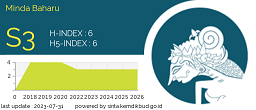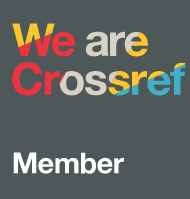- Focus and Scope
- Section Policies
- Open Access Policy
- Author Guidelines
- Copyright and Licensing
- Author Fees
- Publication Ethic
Focus and Scope
The aim of this journal publication is to disseminate the conceptual thoughts or ideas and research results that have been achieved in the area of community services.
MINDA BAHARU, particularly focuses on the main problems in the development of the sciences of community services areas as follows:
- Community Services, People, Local Food Security;
- Training, Marketing, Appropriate Technology, Design;
- Community Empowerment, Social Access;
- Student Community Services;
- Border Region, Less Developed Region;
- Education for Sustainable Development.
Section Policies
Articles
Open Access Policy
This journal provides immediate open access to its content on the principle that making research freely available to the public supports a greater global exchange of knowledge.
Author Guidelines
Judul Artikel, Maksimal 15 Kata, Memberi Gambaran Isi Artikel, ditulis dalam Bahasa Indonesia dan Inggris
Abstrak
Abstrak memuat uraian singkat mengenai masalah dan tujuan pengabdian kepada masyarakat, metode yang digunakan, dan hasil pengabdian kepada masyarakat. Tekanan penulisan abstrak terutama pada hasil pengabdian kepada masyarakat. Abstrak ditulis dalam Bahasa indonesia dan Inggris. Maksimal jumlah kata dalam abstrak adalah 200 kata. (Lihat Template).
Kata Kunci
Jumlah kata-kata kunci maksimal 5 kata. Kata kunci perlu dicantumkan untuk menggambarkan ranah masalah pengabdian dan istilah-istilah pokok yang mendasari pelaksanaan pengabdian kepada masyarakat. Kata-kata kunci dapat berupa kata tunggal atau gabungan kata.
PENDAHULUAN
Bagian pendahuluan terutama berisi: (1) permasalahan pengabdian kepada masyarakat; (2) rumusan tujuan pengabdian kepada masyarakat; (3) solusi yang ditawarkan untuk memecahkan masalah; (4) rangkuman kajian teoritik yang berkaitan dengan penyelesaian masalah; dan (5) harapan akan hasil dan manfaat pengabdian kepada masyarakat.
METODE PELAKSANAAN
Pada dasarnya bagian ini menjelaskan bagaimana pengabdian kepada masyarakat itu dilakukan. Materi pokok bagian ini adalah: (1) Pendekatan/metode/model pelaksanaan pengabdian kepad masyarakat, (2) Sasaran pengabdian kepada masyarakat; (3) Tahapan pelaksanaan pengabdian masyarakat; (4) Proses pengabdian kepada masyarakat dan teknik analisis yang digunakan; (5) Uraian indicator keberhasilan program pengabdian kepada masyarakat yang berlangsung dalam periode waktu tertentu.
HASIL DAN PEMBAHASAN
Bagian ini merupakan bagian utama artikel hasil pengabdian kepada masyarakat dan biasanya merupakan bagian terpanjang dari suatu artikel. Hasil pengabdian kepada masyarakat yang disajikan dalam bagian ini adalah hasil “bersih”. Tabel dan grafik dapat digunakan untuk memperjelas penyajian hasil pengabdian kepada masyarakat secara verbal. Tabel dan grafik harus diberi komentar atau dibahas. Cara penyajian tabel, gambar, grafik dapat dilihat pada Template Jurnal Minda Baharu.
Pembahasan dalam artikel bertujuan untuk: (1) menjawab rumusan masalah dan pertanyaan-pertanyaan pengabdian kepada masyarakat; (2) menunjukkan bagaimana capaian-capaian diperoleh; (3) menginterpretasi/ menafsirkan capaian-capaian dengan menggunakan teori yang digunakan; (4) ketercapaian indicator dikaitkan dengan pelaksanaan program;
KESIMPULAN DAN SARAN
Kesimpulan
Kesimpulan menyajikan ringkasan dari uraian mengenai hasil analisis dan pembahasan, mengacu pada penyelesaian masalah pengabdian kepada masyarakat. Berdasarkan kedua hal tersebut dikembangkan pokok-pokok pikiran baru yang merupakan esensi dari temuan pengabdian kepada masyarakat.
Saran
Saran disusun berdasarkan temuan pengabdian kepada masyarakat yang telah dibahas. Saran dapat mengacu pada tindakan praktis, pengembangan teori baru, penelitian dan/atau keberlanjutan program pengabdian kepada masyarakat.
Ucapan Terima Kasih (jika ada)
Ucapan terima kasih ditepatkan setelah Kesimpulan. Hanya dibuat bila kegiatan penelitian/pengabdian didukung/disponsori oleh pihak/instansi tertentu secara langsung dan berperan besar terhadap hasil dan pelaksanaan pengabdian kepada masyarakat. Ucapan terimakasih dinyatakan dengan jelas dan singkat dan mencamtumkan nomor kontrak/perjanjian dll.
Penulisan Daftar Referensi
Daftar referensi harus lengkap dan sesuai dengan sitasi yang disajikan dalam batang tubuh artikel. Semua sitasi yang telah disebutkan dalam artikel harus dicantumkan dalam Daftar referensi. Daftar referensi disusun secara alfabetis dan cara penulisannya disesuaikan dengan aturan yang ditentukan dalam jurnal. Kaidah penulisan kutipan, sitasi, dan Daftar referensi mengikuti Template Jurnal Baharu Minda Bahari.
Penulisan daftar referensi mengikuti panduan APA (American Psychological Association) edisi ke-6. Dengan mengunakan menajemen referensi MENDELEY. Minimal referensi sebanyak 10 referensi sepuluh tahun terkhir. Semua referensi bisa dilacak secara daring/online.
Contoh penulisan Daftar Referensi
Eromosele, C. and Eromosele, I. (2002). Fatty acid compositions of seed oils of Haematostaphis barteri and Ximenia americana. Bioresour Technol, 82(3): 303–304. (bila bersumber dari jurnal)
Baderan, D.W.K., Hamidun, M.S., Lamangandjo, C., dan Retnowati, Y., (2015). Diversifikasi produk olahan buah mangrove sebagai sumber pangan alternatif masyarakat pesisir Toroseaje, Kabupaten Pohuwato, Provinsi Gorontalo. Pros Semnas Masy Biodiv Indon. Volume 1, Nomor 2:347-351. DOI: 10.13057/psnmbi/m010230 (bila berumber dari prosiding online).
Djajati, S. dan Rosida, D.F., (2015). Pengembangan Produk Olahan Mangrove dan Perikanan di Kawasan Pantai Wonorejo Surabaya. Prosiding Seminar Nasional “Research Month” 2015. “Sinergi Hasil Penelitian dan Pengabdian kepada Masyarakat untuk Menumbuhkan Kapasitas Inovasi di Bidang Teknologi, Pertanian, Sosial dan Ekonomi”. Halaman 381-387. (bila berumber dari prosiding cetak/offline).
Giesen, W., Wulffraat, S., Zieren, M., and Scholten, L. (2007). Mangrove Guide Book For Southeast Asia. FAO and Wetlands International, Dharmasarn Co. Ltd. 769 pp. (bila bersumber dari buku teks)
GBIF Secretariat. (2017). GBIF Backbone Taxonomy. Checklist dataset. https:// doi.org/10.15468/39omei accessed via GBIF.org on 2018-07-29. (bila bersumber dari wabside)
Copyright and Licensing
MINDA BAHARU uses an exclusive license agreement. The author will defend the copyright along with the scientific use rights and Riau Kepulauan University will be given the rights to issue and distribute.
Open author access retains the copyright of their paper, and all open articles are distributed under the terms of the Creative Commons Attribution License (CC-BY), which allows others to distribute and copy articles provided the original work is properly quoted.
Users cannot represent authors as support for the adaptation of their articles and do not change articles in such a way as to damage the honor or reputation of the author.
This work is licensed under a Creative Commons Attribution 4.0 International License.
Author Fees
Minda Baharu Journal
This journal charges the following author fees.
Article Submission: 0.00 (IDR)
Authors are not required to pay an Article Submission Fee as part of the submission process to contribute to review costs.
Article Publication: 750.000.00 (IDR), for those who choose the faster process will be incharge 250.000.00 (IDR)
If this paper is accepted for publication, you will be asked to pay an Article Publication Fee to cover publications costs.
Publication Ethic
Publication Ethics
Duties of Authors
- Reporting Standards:
Authors of reports of original research should present an accurate account of the work performed as well as an objective discussion of its significance. Underlying data should be represented accurately in the paper. A paper should contain sufficient detail and references to permit others to replicate the work. Fraudulent or knowingly inaccurate statements constitute unethical behavior and are unacceptable.
- Data Access and Retention:
Authors are asked to provide the raw data in connection with a paper for editorial review, and should be prepared to provide public access to such data (consistent with the ALPSP-STM Statement on Data and Databases), if practicable, and should in any event be prepared to retain such data for a reasonable time after publication.
- Originality and Plagiarism: The authors should ensure that they have written entirely original works, and if the authors have used the work and/or words of others that this has been appropriately cited or quoted.
- Multiple, Redundant or Concurrent Publication:
An author should not, in general, publish manuscripts describing essentially the same research in more than one journal or primary publication. Submitting the same manuscript to more than one journal concurrently constitutes unethical publishing behavior and is unacceptable.
- Acknowledgment of Sources:
Proper acknowledgment of the work of others must always be given. Authors should cite publications that have been influential in determining the nature of the reported work.
- Authorship of the Paper:
Authorship should be limited to those who have made a significant contribution to the conception, design, execution, or interpretation of the reported study. All those who have made significant contributions should be listed as co-authors. Where there are others who have participated in certain substantive aspects of the research project, they should be acknowledged or listed as contributors. The corresponding author should ensure that all appropriate co-authors and no inappropriate co-authors are included on the paper and that all co-authors have seen and approved the final version of the paper and have agreed to its submission for publication.
- Disclosure and Conflicts of Interest:
All authors should disclose in their manuscript any financial or other substantive conflicts of interest that might be construed to influence the results or interpretation of their manuscript. All sources of financial support for the project should be disclosed.
- Fundamental errors in published works:
When an author discovers a significant error or inaccuracy in his/her own published work, it is the author’s obligation to promptly notify the journal editor or publisher and cooperate with the editor to retract or correct the paper.
- Hazards and Human or Animal Subjects:
If the work involves chemicals, procedures or equipment that have any unusual hazards inherent in their use, the author must clearly identify these in the manuscript.
Duties of Editors
- Fair Play:
An editor at any time evaluates manuscripts for their intellectual content without regard to race, gender, sexual orientation, religious belief, ethnic origin, citizenship, or political philosophy of the authors.
- Confidentiality:
The editor and any editorial staff must not disclose any information about a submitted manuscript to anyone other than the corresponding author, reviewers, potential reviewers, other editorial advisers, and the publisher, as appropriate.
- Disclosure and Conflicts of Interest:
Unpublished materials disclosed in a submitted manuscript must not be used in an editor's own research without the express written consent of the author.
- Publication Decisions:
The editor board journal is responsible for deciding which of the articles submitted to the journal should be published. The validation of the work in question and its importance to researchers and readers must always drive such decisions. The editors may be guided by the policies of the journal's editorial board and constrained by such legal requirements as shall then be in force regarding libel, copyright infringement and plagiarism. The editors may confer with other editors or reviewers in making this decision.
- Review of Manuscripts:
The editor must ensure that each manuscript is initially evaluated by the editor for originality. The editor should organize and use peer review fairly and wisely. Editors should explain their peer review processes in the information for authors and also indicate which parts of the journal are peer reviewed. The editor should use appropriate peer reviewers for papers that are considered for publication by selecting people with sufficient expertise and avoiding those with conflicts of interest.
Duties of Reviewers
- Contribution to Editorial Decisions:
Peer review assists the editor in making editorial decisions and through the editorial communications with the author may also assist the author in improving the paper.
- Promptness:
- Standards of Objectivity:
Reviews should be conducted objectively. Personal criticism of the author is inappropriate. Referees should express their views clearly with supporting arguments.
- Confidentiality:
- Disclosure and Conflict of Interest:
Privileged information or ideas obtained through peer review must be kept confidential and not used for personal advantage. Reviewers should not consider manuscripts in which they have conflicts of interest resulting from competitive, collaborative, or other relationships or connections with any of the authors, companies, or institutions connected to the papers.
- Acknowledgment of Sources:
Reviewers should identify relevant published work that has not been cited by the authors. Any statement that an observation, derivation, or argument had been previously reported should be accompanied by the relevant citation. A reviewer should also call to the editor's attention any substantial similarity or overlap between the manuscript under consideration and any other published paper of which they have personal knowledge.

















